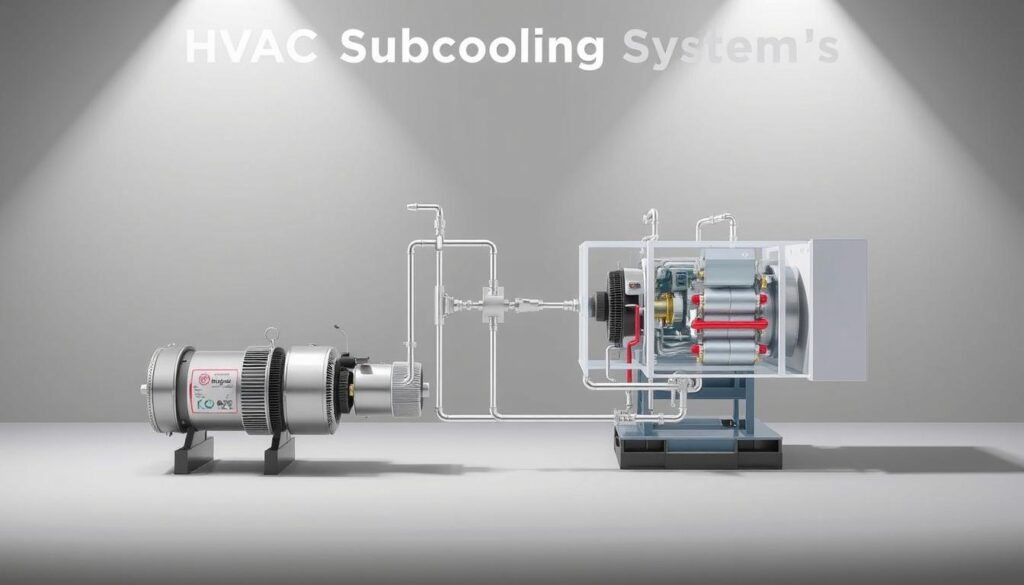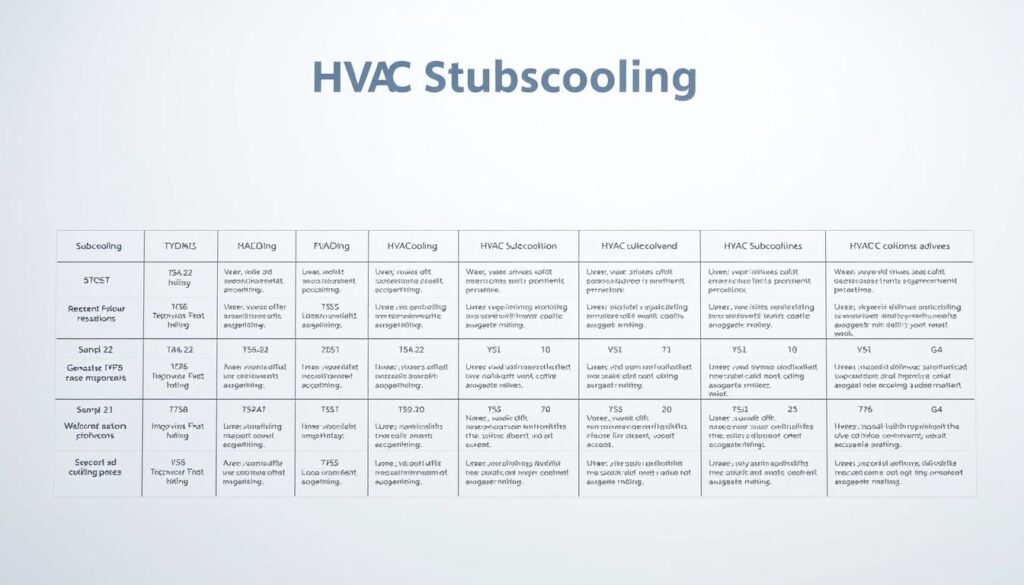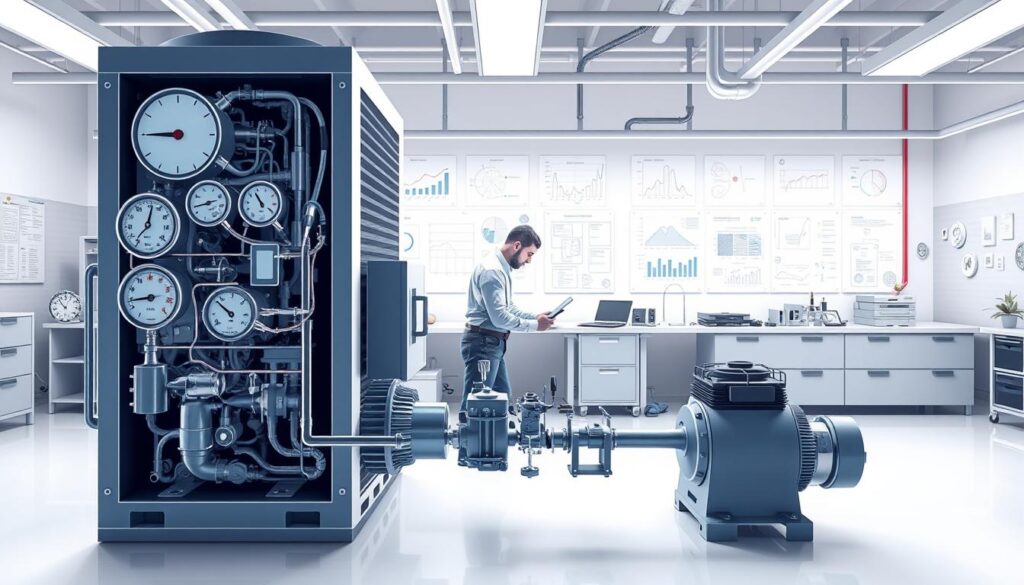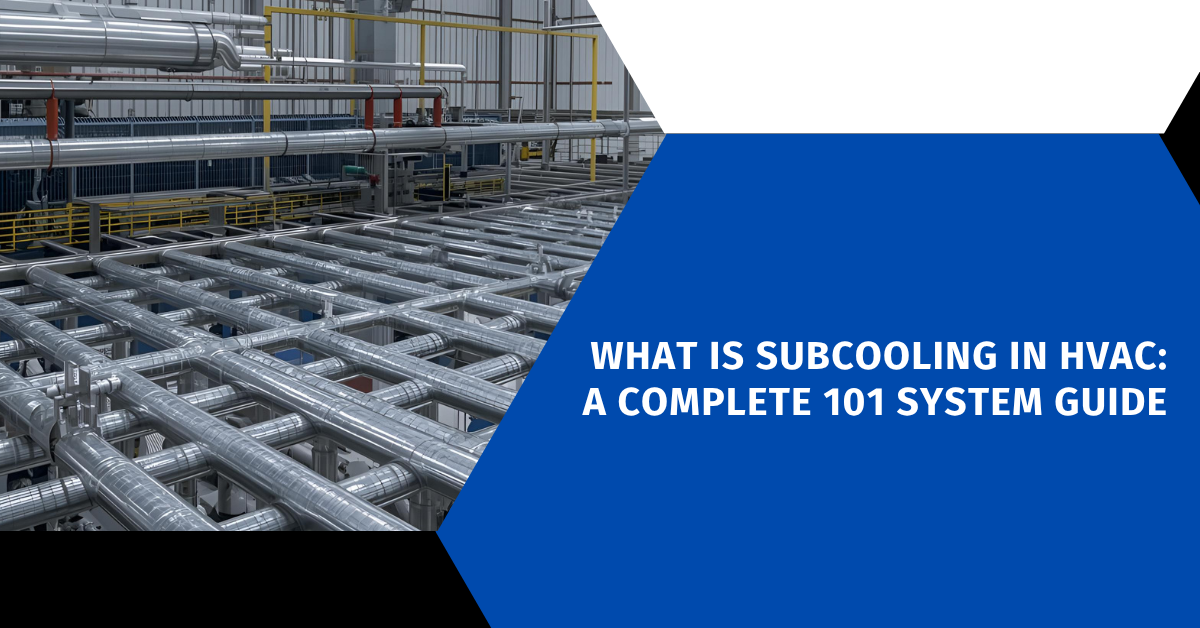What Is Subcooling in HVAC? Ever wondered why your AC works great even when it’s super hot outside? The answer might be in a process called subcooling in HVAC systems.

Subcooling is key in refrigeration and boosts your system’s performance. When refrigerant cools below its condensation point, it becomes more efficient. This helps your HVAC system work at its best.
Learning about subcooling in HVAC helps you understand your cooling system better. It’s not just about keeping things cool. It also affects your system’s energy use and how well it works.
Key Takeaways
- Subcooling is essential for optimal HVAC system performance
- Refrigerant undergoes critical temperature transformations during the cooling cycle
- Proper subcooling ensures maximum energy efficiency
- HVAC systems rely on precise refrigerant management
- Temperature and pressure relationships are critical in subcooling
Table of Contents
Understanding the Fundamentals of Subcooling
Exploring HVAC systems means learning about refrigerants. The process of refrigerant subcooling is key for efficient cooling. Your HVAC system uses heat transfer to manage temperature and pressure.
Refrigerants are vital in HVAC technology. They move heat and make spaces comfortable. Knowing subcooling vs superheat helps improve system performance.
Basic Principles of Heat Transfer
Heat transfer in HVAC systems happens in three ways:
- Conduction: Direct heat transfer through solid materials
- Convection: Heat movement through liquids and gases
- Radiation: Heat transfer through electromagnetic waves
The Role of Refrigerant in HVAC Systems
Refrigerants are essential for cooling systems. They change phase to absorb and release heat, controlling temperature.
| Refrigerant Property | Impact on HVAC Performance |
|---|---|
| Phase Change Capability | Enables efficient heat absorption and release |
| Pressure-Temperature Relationship | Drives the refrigeration cycle |
| Thermal Conductivity | Determines heat transfer efficiency |
Temperature and Pressure Relationships
In refrigeration cycles, temperature and pressure are closely linked. When refrigerant temperature goes up, pressure also increases. This is key to understanding refrigerant subcooling and system performance.
Explore Our HVAC Shop
Looking for top-rated HVAC tools, parts, and accessories? Visit our shop and find the perfect solution for your needs.
Visit the ShopWhat Is Subcooling in HVAC
Subcooling in HVAC is a key technique for keeping your cooling system running smoothly. It involves cooling the liquid refrigerant below its condensing point. This keeps it in a liquid state.
After the condensation process, the refrigerant cools further. This extra cooling brings several benefits:
- Improved system efficiency
- Enhanced cooling capacity
- Reduced risk of compressor damage
Carrier subcooling recommendations stress the need for precise refrigerant temperatures. Most systems aim for 10-15 degrees of subcooling. This helps avoid performance problems.
Proper subcooling ensures your HVAC system transforms heat energy more effectively, leading to better overall cooling performance.
Different HVAC systems need different subcooling levels. Residential and commercial systems have different needs. It’s important to know what your system requires.
By controlling subcooling, you can make your HVAC system more energy-efficient. This also helps extend its life.
The Science Behind Refrigerant Subcooling
Refrigerant subcooling is a complex science that powers HVAC systems. It’s key to understanding how cooling and heating systems work. The calculation of refrigerant subcooling helps us grasp these processes.
Refrigerants change states in the cooling cycle, making heat exchange possible. This change is based on several scientific principles. These principles are essential for the system’s efficiency.
Phase Change Process
The phase change of refrigerants is vital for subcooling in heat pumps. This process involves changes in temperature and pressure:
- Liquid refrigerant enters the condenser
- Temperature drops below condensation point
- Additional heat is removed from the liquid state
Thermodynamic Principles
Subcooling depends on thermodynamic interactions. It uses two main heat transfer concepts:
- Latent Heat: Energy absorbed or released during phase changes
- Sensible Heat: Temperature modification without phase transformation
Heat Exchange Mechanics
| Heat Exchange Stage | Key Characteristics | Temperature Impact |
|---|---|---|
| Condensation | Refrigerant transforms from gas to liquid | Decreases rapidly |
| Subcooling | Additional cooling below condensation point | Continues temperature reduction |
| Heat Rejection | Removes excess thermal energy | Stabilizes system performance |
Knowing these scientific principles helps optimize refrigerant subcooling. This ensures your HVAC system works at its best. The complex heat transfer process is what keeps your system running smoothly.
Explore Our HVAC Shop
Looking for top-rated HVAC tools, parts, and accessories? Visit our shop and find the perfect solution for your needs.
Visit the ShopMeasuring and Calculating Subcooling Values
Knowing how to measure subcooling is key to keeping your HVAC system running well. It helps you understand how your system is doing and spot problems early. This way, you can fix them before they get worse.
To measure subcooling right, you need the right tools and a clear plan. Here’s how to do it:
- Use a reliable digital manifold gauge set
- Get an accurate thermometer
- Find the liquid line near the condenser
- Measure the refrigerant’s pressure and temperature
The formula for measuring subcooling is simple: Subcooling = Saturated Condensing Temperature – Liquid Line Temperature. Let’s look at an example:
| Measurement Point | Temperature | Pressure |
|---|---|---|
| Saturated Condensing Temperature | 120°F | 250 PSI |
| Liquid Line Temperature | 105°F | 235 PSI |
| Subcooling Calculation | 15°F | – |
“Accurate subcooling measurement is the key to maintaining your HVAC system’s peak performance.” – HVAC Professional
Experts say to check subcooling during regular maintenance. The right subcooling level depends on the refrigerant and system design. Most homes aim for 10-15°F of subcooling, but it can change.
Calculating refrigerant subcooling can reveal system problems like:
- A blocked liquid line
- A system that’s under or overcharged
- A faulty expansion valve
- Issues with the condenser
Learning how to measure subcooling helps your HVAC system work better. This can save you money on energy and avoid expensive repairs.
Subcooling vs Superheat: Key Differences
It’s important to know the difference between subcooling and superheat for your HVAC system. These processes are key to keeping your system running well. They help with heat transfer and protect your system.
Subcooling and superheat do different things in your cooling system. Even though they seem alike, they work in different ways.
Operating Principles
The main difference between subcooling and superheat is where they happen in the cooling cycle:
- Subcooling happens after condensation, cooling the liquid refrigerant below its boiling point
- Superheat occurs after evaporation, heating the vapor refrigerant above its boiling point
System Requirements
Measuring subcooling and superheat needs exact temperature and pressure checks. Your HVAC system needs specific conditions for each:
- Subcooling makes sure the liquid refrigerant is fully condensed
- Superheat stops liquid refrigerant from getting into the compressor
Measurement Techniques
Technicians use special tools to measure subcooling and superheat. Temperature probes and pressure gauges are used. They help keep your system safe and running at its best.
Keeping a balance between subcooling and superheat is key for your HVAC system’s best performance.
Normal Subcooling Readings and Target Values
Knowing normal subcooling readings is key for your HVAC system’s best performance. Both technicians and homeowners must understand the target subcooling values. This ensures your cooling system works efficiently.

- Refrigerant type
- System design specifications
- Operating environmental conditions
- Manufacturer recommendations
For most home air conditioning systems, the normal subcooling readings are between 8 to 12 degrees Fahrenheit. Commercial and industrial systems might need slightly different values, depending on their specific needs.
| System Type | Typical Subcooling Range | Optimal Performance Indicators |
|---|---|---|
| Residential Split Systems | 8-12°F | Efficient cooling, low energy consumption |
| Commercial HVAC | 10-15°F | Enhanced system reliability |
| Industrial Refrigeration | 12-18°F | Maximum thermal efficiency |
Keeping the right subcooling target values is vital. It stops problems like compressor damage, lower efficiency, and higher energy bills. Regular checks and professional upkeep keep your HVAC system running smoothly.
The Importance of Proper Subcooling in System Performance
Proper subcooling is key to your HVAC system’s performance. It affects efficiency, longevity, and costs. Knowing about subcooling helps keep your heating and cooling system running well.
Subcooling does more than just measure temperature. It ensures the refrigerant flows right and the system works well.
Energy Efficiency Benefits
Carrier subcooling offers big energy savings:
- It makes refrigerant flow better and heat transfer more efficient.
- It cuts down the compressor’s work, saving energy.
- It lowers energy use, saving you money.
- It boosts your system’s performance overall.
System Longevity
Right subcooling helps your HVAC system last longer. It keeps refrigerant conditions steady, avoiding stress on parts.
| Subcooling Impact | System Component | Benefit |
|---|---|---|
| Optimal Refrigerant Condition | Compressor | Reduced Wear and Tear |
| Consistent Liquid Flow | Expansion Valve | Precise Refrigerant Metering |
| Stable Temperature | Condenser | Enhanced Heat Exchange |
Operating Cost Reduction
Using precise subcooling cuts down your HVAC system’s costs. Good refrigerant management means lower energy bills and less maintenance costs.
Explore Our HVAC Shop
Looking for top-rated HVAC tools, parts, and accessories? Visit our shop and find the perfect solution for your needs.
Visit the ShopCommon Subcooling Issues and Troubleshooting
Understanding how to fix subcooling problems is key to keeping your HVAC system running well. Spotting issues early can save you from expensive fixes and keep your system running smoothly.

Getting the right subcooling readings helps find common problems that affect your HVAC system:
- Low Subcooling Symptoms
- Inconsistent cooling performance
- Reduced system efficiency
- Potential compressor damage
- High Subcooling Indicators
- Increased energy consumption
- Restricted refrigerant flow
- Potential metering device malfunction
Here are some steps to fix subcooling problems:
- Check refrigerant charge levels
- Inspect condenser functionality
- Evaluate metering device performance
- Verify temperature and pressure readings
When dealing with subcooling issues, focus on precise measurements and a systematic approach. HVAC experts suggest regular checks to avoid problems and keep your system at its best.
“Accurate subcooling measurement is the key to identifying and resolving HVAC system inefficiencies.”
Subcooling in Different HVAC Applications
Subcooling is key in various HVAC systems. It’s about managing temperatures precisely. Each system needs its own way to work best and save energy.
Refrigeration systems have common parts. But, they need different subcooling levels based on their use and needs.
Residential Systems: Heat Pump Considerations
Heat pumps rely on subcooling to work well. Carrier suggests keeping the temperature between 10-12°F for the best results:
- Ideal subcooling is between 10-12°F
- Right refrigerant charge stops system waste
- Keep it maintained for steady subcooling
Commercial HVAC Units
Commercial systems need special subcooling plans. They use variable refrigerant flow to handle different temperatures in big areas.
| System Type | Typical Subcooling Range | Performance Impact |
|---|---|---|
| Small Commercial Units | 8-10°F | Moderate Efficiency |
| Large Commercial Systems | 10-15°F | High Efficiency |
Industrial Refrigeration Applications
Industrial systems need very precise subcooling. Critical temperature control is essential for strict thermal management.
Precision in subcooling can mean the difference between optimal performance and system failure.
Knowing about subcooling in different HVAC systems helps. It improves performance, cuts energy use, and makes equipment last longer.
Explore Our HVAC Shop
Looking for top-rated HVAC tools, parts, and accessories? Visit our shop and find the perfect solution for your needs.
Visit the ShopBest Practices for Maintaining Optimal Subcooling
Keeping your HVAC system’s subcooling at the right level is key. Experts say following certain steps is essential for top performance.
- Regular refrigerant charge inspections
- Cleaning condenser coils thoroughly
- Monitoring system pressure levels
- Checking for refrigerant leaks
Carrier suggests getting professional help often. Your HVAC needs regular checks to keep subcooling just right.
| Maintenance Task | Recommended Frequency | Key Benefits |
|---|---|---|
| Refrigerant Level Check | Annually | Prevents efficiency loss |
| Condenser Coil Cleaning | Bi-annually | Improves heat transfer |
| Professional System Diagnostic | Annually | Ensures optimal performance |
Always hire certified HVAC pros to tweak subcooling. They can spot and fix problems while keeping your system in line with the manufacturer’s specs.
Proactive maintenance is your best strategy for long-term HVAC system reliability and energy efficiency.
Conclusion
Understanding subcooling in HVAC is key to keeping cooling systems running well. Knowing about subcooling helps your HVAC last longer and work better. It’s all about how refrigerant temperature affects system efficiency.
Subcooling is more than just numbers. It makes your system use less energy, which means lower costs. If you get subcooling right, your system will last longer and work better.
Good HVAC maintenance means paying attention to subcooling. Regular checks and knowing how to handle refrigerant are important. This helps your cooling system work its best, saving energy and keeping things reliable.
Learning about subcooling shows you care about your HVAC system. By using what you’ve learned, your cooling systems will run smoothly. This means more comfort and less energy use, saving you money in the long run.

